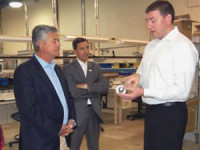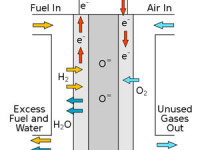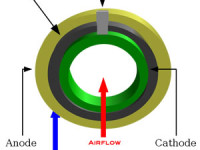
Solid Oxide Fuel Cells (SOFC) are positioned to provide an economical and viable alternative to small electrical generators in the near future, according to WATT Fuel Cell company that prepared for initial product rollouts of its products in 2013. Defense-Update reports. The company has recently concluded testing on a 500-watt propane-powered unit and is planning to demonstrate a 1-kilowatt systems by the end of this year. “Being able to use accessible fuel is key to the success of the fuel cell industry, and we’ve focused on our technology’s ability to use readily available gaseous and liquid fuels for commercial and military applications,” Dr. Caine Finnerty, president of WATT Fuel Cell said. Propane and natural gas will be used commercially, while liquid fuels such as Diesel (D2) and JP-8 will be suitable for the military.
As part of the system’s commercialization WATT has recently refined its patented cell manufacturing process, substantially reducing production times while increasing part quality, performance and yield. “Our process not only makes cost-effective stack manufacturing a reality, but also permits manufacturing scalability to quickly flex, matching market demand,” said Benjamin Emley, technology director at the company. According to Emley, the company is presently scaling into full-rate production at its manufacturing facility on Long Island.

Earlier this week Parker Hannifin and WATT Fuel Cell Corp. embarked on a strategic licensing and supply agreement to bring WATT’s propane-driven Solid Oxide Fuel Cell (SOFC) based products to commercial markets.The agreement will provide Parker’s an exclusive license of WATT Fuel Cell’s low-cost balance-of-plant (BoP) technology and exclusive stack supply for use in 500 to 3000 watt RV, marine and over-the-road trucking markets. Parker will manufacture the BoP and controls and also integrate the fuel cell stacks into complete, packaged SOFC products.
While the agreement with Parker aims at the commercial sector, the SOFC fuel-cell has many military applications as well, particularly with systems operating on JP-8 fuel. With such capability the fuel cell provides a powerful, quiet and logistically efficient energy source for various users, including robotics or unattended communications devices. WATT Fuel Cell has already integrated systems operating on both gaseous and liquid fuel. The fuel cell system replaces batteries offering six times the capacity for a given net weight (the weight of batteries providing less than 200 Wh/kg can be replaced by JP-8 fuel cell driving more than 12,000 Wh/kg). Key for performance improvement is the reduction in the size of the fuel cell and its electronic control circuits.

WATT Fuel Cell has identified several key applications within the military including UAVs, UGV’s, battery chargers and primary power to forward deployed forces. “We have taken a simplified approach to system and stack design in order to streamline production and product support. Reduction in system cost and standardization of componentry across various power platforms will enable us to provide a better product to the end user” Emley explained.
















